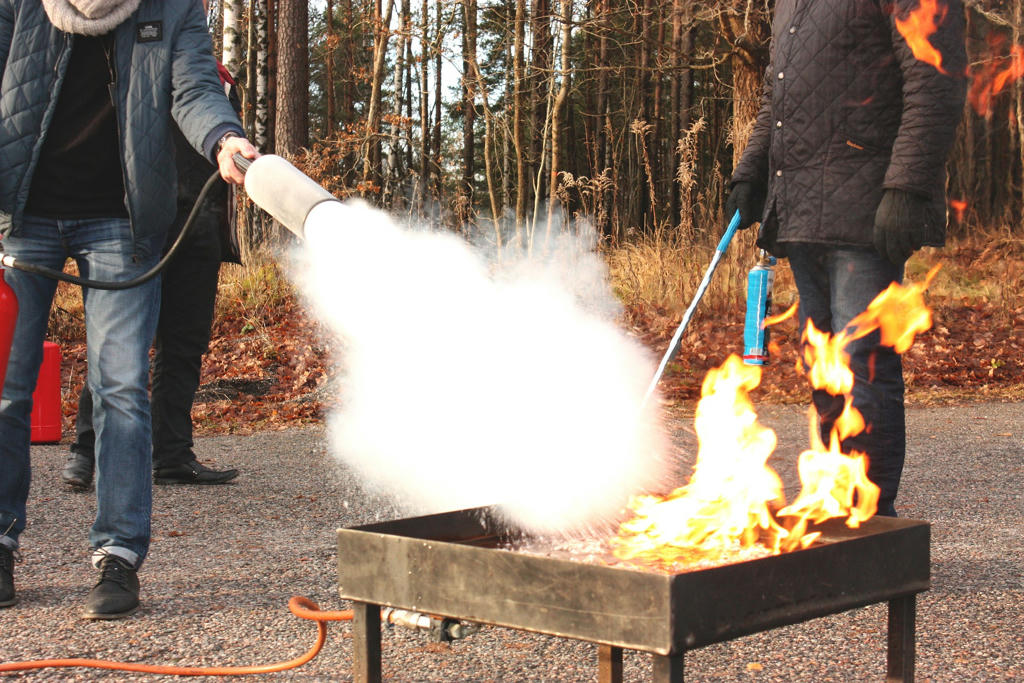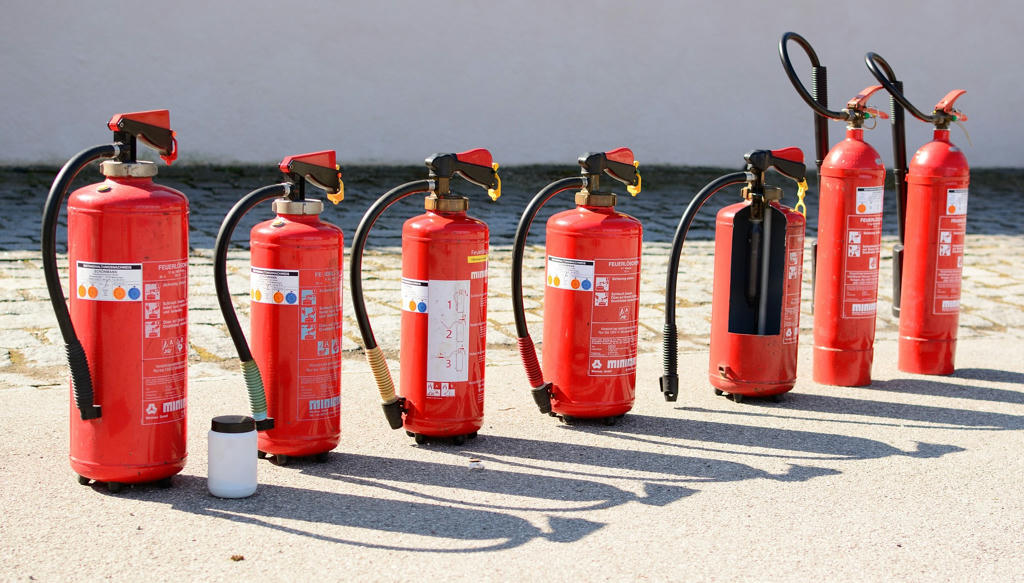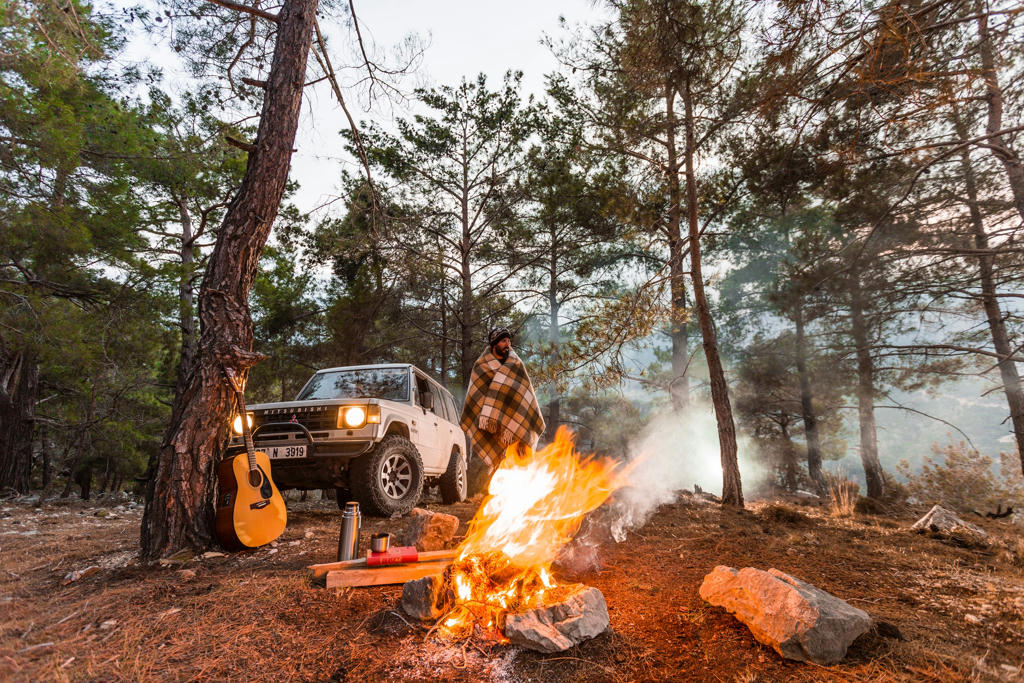Fire extinguishers are an integral part of fire safety, but most people probably won’t have to use one in their lives. Regardless, knowing how one works can be the deciding factor between life and death in a dangerous situation.
Can a Fire Extinguisher be Used on a Person? The short answer is, yes. A fire extinguisher can be used on a person if the fire is directly on them and spreading quickly. There are still specific steps and safety precautions that should be taken when using a fire extinguisher on a person.
There are multiple factors to consider other than using the fire extinguisher to put out the fire. You must consider if it is the best option for the person, how it will affect the individual’s health, and what to do after the fire is contained. But there are other ways to put out a fire other than an extinguisher. We’ll go through all of them.
How to Use a Fire Extinguisher to Put Out a Fire on a Person
A fire extinguisher should be used on a person if it is the only option that can save their life. It’s recommended that other tactics be tested before the use of a fire extinguisher, as they are primarily designed to put out fires on objects, land, and other property. But if a fire extinguisher must be used, specific and cautious steps must be taken.
The first thing to do is let the person know that they are on fire. This will give them the chance to possibly brush off the flames themselves and save you from having to use the extinguisher. If they are unable to do so, tell them to cover their face. This includes:
- Eyes
- Mouth
- Nose
This will prevent them from inhaling the contents of the extinguisher and lessen the risk of health hazards.
Check the MSDS (Material Safety Data Sheet) to find out if there is a possible inhalation hazard that can harm the person’s health.
When using the fire extinguisher, do not spray the person’s face where the contents can be inhaled. You should also avoid skin or clothes that are not burning if possible.
Once the fire is out, immediately begin attending to the person’s health. This means:
- Removing the person to fresh air
- Treating the victim’s burns
- Contacting medical or emergency professionals if needed
How Someone Might Catch on Fire
There are multiple ways a person can catch on fire. The most common ways are:
- A loose sleeve catching a spark from a gas stove
- Working with gasoline or other flammable liquids
- Lighting a cigarette around flammable vapors
- Spraying lighter fluid on an already smoldering fire
Regardless of how someone catches on fire, the most important thing is putting the fire out immediately to minimize injuries and other damage.
Is Breathing in The Contents of a Fire Extinguisher Bad?
Depending on the type of fire extinguisher used, the health effects can be menial and easily treated, or will need more serious medical attention. It is recommended that as little be inhaled as possible, hence covering/not spraying the face of the fire victim.

Types of Fire Extinguishers And Their Health Effects
- CO2 Extinguishers
- Dry-Powder Chemical Extinguishers
- Soda-Acid Extinguishers
1. CO2 Extinguishers
These extinguishers are meant to control electrical fires and those involving flammable liquids. It releases a blanket of CO2 (carbon dioxide) gas that deprives the fire of air, essentially suffocating it. Its health effects include:
- Causing frostbite to occur on exposed parts of the body *
- Suffocation
- Giddiness
- Lightheadedness
- Shortness of breath
- Muscle tremors
- In extreme cases, unconsciousness, and death.
2. Dry-Powder Chemical Extinguishers
This is the most common type of fire extinguisher. Dry-powder extinguishers put out fires caused by easily flammable materials (paper, cloth, etc). They typically have a white, powdery, snow-like substance called sodium bicarbonate in them that smothers the fire. But some can have a mono ammonium phosphate, which comes out as a yellow powder. Both will suffocate the fire and put it out efficiently. This one is very effective in putting out fires on people, since the clothes people wear are made from cloth, and this extinguisher is designed to handle fires burning from cloth. This does not come without side effects, however. The least harm these chemical extinguishers can cause is:
- Respiratory tract irritation
- Coughing
- Shortness of breath.
The most harm is if it gets into an open wound, where it can:
- Damage the skin.
- Cause Infections
- Blood poisoning (sepsis)
- Toxic Shock Syndrome
If an abundance is inhaled, it can cause:
- Organ failure
- The lungs to fill up with fluid
- Breathing problems
- Poor oxygenation of blood
3. Soda-Acid Extinguishers
These extinguishers can be used for fires that involve easily flammable materials as well. But the mechanics are a bit different. They contain a sodium bicarbonate and a flask of sulphuric acid. The acid chemically reacts with the sodium bicarbonate to form carbon dioxide gas. Similar to CO2 extinguishers, this smothers the fire and puts it out. Inhaling these components can cause irritation to the nose, throat, and lungs. This can result in:
- Coughing
- Shortness of breath
- Dizziness
- Headaches
It is important to know what kind of fire extinguisher you have so you know how to use it and how to treat the effects of it.
How to Use Most Fire Extinguishers
The steps to using almost any fire extinguisher can be remembered by using the acronym PASS:
- P-Pull out the Safety pin
- A- Aim the nozzle of the extinguisher at the fire
- S-Squeeze the handle
- S- Sweep and spray from side to side
Treating the Effects of a Fire Extinguisher
While the fire extinguishers themselves are different, the way you treat a person affected by the contents of all three is simple.
If you suspect a person has inhaled too much, get them to fresh air immediately. The longer they are around the fumes of the extinguisher, the more they inhale, the more toxic and dangerous it can be.
If the victim’s eyes or skin were exposed to any of the contents of the dry chemical extinguishers, immediately rinse the affected areas. After these precautions are taken, contact poison control to make sure the person is properly treated.
Which Extinguisher is The Best One to Have?
There are five main classifications for fires in the United states. And while there are only three types of extinguishers, each fire can be put out with one of the three. It really just comes down to which fire and fire extinguisher combination is the most effective.

Types of Fires
- Class A
- Class B
- Class C
- Class D
- Class K
1. Class A
These fires involve ordinary materials you use in your daily life. These include:
- Wood
- Paper
- Plastic
- Cloth
- Trash
They can start out small, and if they are put out immediately, are not that much of a threat. However, if there is an abundance of material in one place (wood pile, trash dumpster, etc), it can spread quickly and become more deadly. These fires should be put out with a dry chemical fire extinguisher. Both a mono ammonium and sodium bicarbonate chemical powder will work.
2. Class B
Class B fires originate from flammable liquids such as:
- Gasoline
- Alcohols
- Non-cooking oils (motor oil, engine oil, etc.)
- Grease
- Solvents
These are not too common, but they can be avoided by being careful when using these liquids. These fires can also be put out with a dry-powder chemical extinguisher, but only an extinguisher with a sodium bicarbonate powder should be used.
These fires can also be put out using a CO2 extinguisher. And unlike the dry chemical fire extinguishers that can leave behind toxic powders, these do not usually leave behind any residue. The only exception is if there is too much CO2 used, perhaps to put out or control a large and rapidly growing fire.
3. Class C
These fires involve electrical equipment such as:
- Computers
- Appliances
- Power tools
These mainly happen when one of these is plugged into a hot electrical outlet, faulty cords, or outdated appliances. Again, these are not that common and can be easily avoided if the right precautions of updating your technology are taken. These fires are dangerous because they can happen spontaneously, like a ticking time bomb. You can also use a dry-powder chemical extinguisher for these fires. Specifically, a sodium bicarbonate chemical powder.
CO2 fire extinguishers can also be used to put out electrical fires. Since CO2 is not a conductor of heat, it will not increase the size of the fire. Rather, it will displace the air the fire is using for fuel and combustion, diminishing it efficiently.
You should never use water to put out these fires. It is extremely ineffective and can spread the fire even faster, especially if it’s an electrical fire. This is because water is actually a great conductor and will help the fire rather than hurting it.
4. Class D
This classification of fires is mainly associated with manufacturing companies. They originate from combustible metals, such:
- Lithium
- Zirconium
- Titanium
Unless you have a strong interest in chemistry or combustibility, you don’t really need to worry about these fires. Class D fires should be put out with a dry chemical powder extinguisher. The powder will absorb the heat as well as suffocating it and extinguish the flames.
5. Class K
As the namesake suggestions, these fires are common in commercial kitchens, such as kitchens in restaurants or fast food places. These fires are due to the cooking oils and grease in the deep fat fryers of restaurants. These fires can be very dangerous in dining facilities since there is an abundance of fuel concentrated into one place. They are not common in homes, but if you do have a fryer or use a pan to fry food, be very cautious, let the oils or grease cool down before you wash the dishes, and make sure the area is clear of flammable liquids.
Class K fires are put out with a process called saponification. This process involves the conversion of fats, oils, and lipids into soap and alcohol by using a wet chemical. There are specially designed extinguishes for this, but they are only used in kitchens and most people do not have to be concerned about using them. However, if you must put out a kitchen fire in your home, smother it with baking soda or salt immediately. A wet towel or cloth can also be used if the fire is small. If it gets out of control, get out of the house and call emergency services immediately.
Overall, the best fire extinguisher to have for your home is a dry powder one. These extinguishers are able to put out the most fires (Class A, B, and C) and while they can be toxic, their toxicity can also be treated effectively and avoided easily.

Putting Out a Fire on a Person
The first thing a person should never do when they are on fire is run. Running will give the fire more oxygen and make it more intense, increasing the chance for injury and damage to their clothes. There are other ways to put out a fire. They include:
- Stop, Drop, Roll
- Smooth Filament Fire Blanket
- Heavy Tightly Woven Blanket
- Water
1. Stop, Drop, Roll
The best and quickest option if it is a small fire is to stop, drop, and roll. The steps are pretty self explanatory; you stop where you are, get on the ground, and roll around to suffocate the fire. They should stop rolling when a fire filament blanket is placed on them to smoother any remaining flames.
2. Fire Emergency Blanket
This is the best option to put out a human torch fire. This is when a person’s clothes are on fire, and the flames can spread very quickly and cause immense harm to the person wearing them.
3. Heavy Tightly Woven Blanket
If you do not have a fire blanket, using a heavy, tightly-woven blanket or another piece of fabric will do the trick.
4. Water
Using water to put out a fire on a person is also not a bad idea, but should be considered as a last resort. Water can increase the risk of wounds getting infected, and it is not the most effective way to extinguish flames anyway.
How to Treat Burns
Once the fire is out, the victim must be treated for burns immediately. This will prevent the risk of:
- Infection
- Blood poisoning
- Toxic shock.
All burns are susceptible to these side effects, as bacteria can very easily enter broken skin.
Another thing all burns have in common is the possibility of contracting Tetanus. This is a bacterial infection that attacks the nervous system and leads to issues with muscle contractions. Burns also carry the risk of hypothermia and hypovolemia.
Hypothermia is when your body has a dangerously low body temperature. This is promoted by the excessive loss of body heat from an injury. Hypovolemia is when your body has a very low blood volume. This can be accelerated when your body loses too much blood as a result of severe burns.
The above circumstances only happen when there are multiple severe burns on a person’s body. There are many ways to treat less severe burns at home, but calling medical professionals is most likely the best option.
First Degree Burns
First degree burns are mainly red, with some minor inflammation and swelling and pain, and dry, peeling skin. They usually heal within seven to ten days without scarring. These burns are the easiest to treat and can be treated with simple home remedies, including:
- Soaking the wound in cold water
- Taking a pain relief medication (ibuprofen, Midol, acetaminophen, etc.)
- Apply aloe vera to the skin to soothe the burn
- If the burn is more severe, using loose gauze or an antibiotic ointment
When treating the burn, make sure you do not use ice, as this can make the damage worse. You should also not use cotton because the small fibers can stick to the injury and increase the risk of infection. Also avoid remedies that use butter or eggs, as these have been disproven and do not work.
Second Degree Burns
Second degree burns extend past the top layer of the skin, making the skin more likely to blister and be extremely red and sore. Some blisters can pop open and make the skin look wet. If this happens, the most important thing is to keep the wound clean, since the popping blisters can be prone to infection. These burns can take up to three weeks to heal, but these treatments can help to speed up the process:
- Running the skin under cold water for fifteen minutes
- Taking over-the-counter medication
- Applying antibiotic cream to blisters
- In extreme cases, skin grafting (taking healthy skin and moving it to the damaged skin to help it heal) is used to heal the burns and blisters
However, if the burns are on a widespread area such as the hands, face, or feet, seek professional medical attention immediately.
Third Degree Burns
These burns are the most severe, as they extend through every layer of skin. They are not as painful though, because the damage is so intense there might be nerve damage, preventing the victim from feeling anything. Third degree burns can appear:
- Charred
- Have a leathery texture
- Have blisters that do not develop.
You should never attempt to treat a third degree burn on your own. You must call emergency services immediately. These burns are the most prone to infections, blood loss, toxic shock, and can be fatal if there are enough of them.
If you know what to do and the safety precautions to take, using a fire extinguisher to help someone on fire is a safe decision. As far as which one to use, the best fire extinguisher is a dry powder one. These extinguishers can put out the most fires (Class A, B, and C) and present the least harm to people. While they can be toxic, their toxicity can also be treated effectively and avoided easily.
